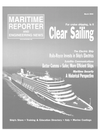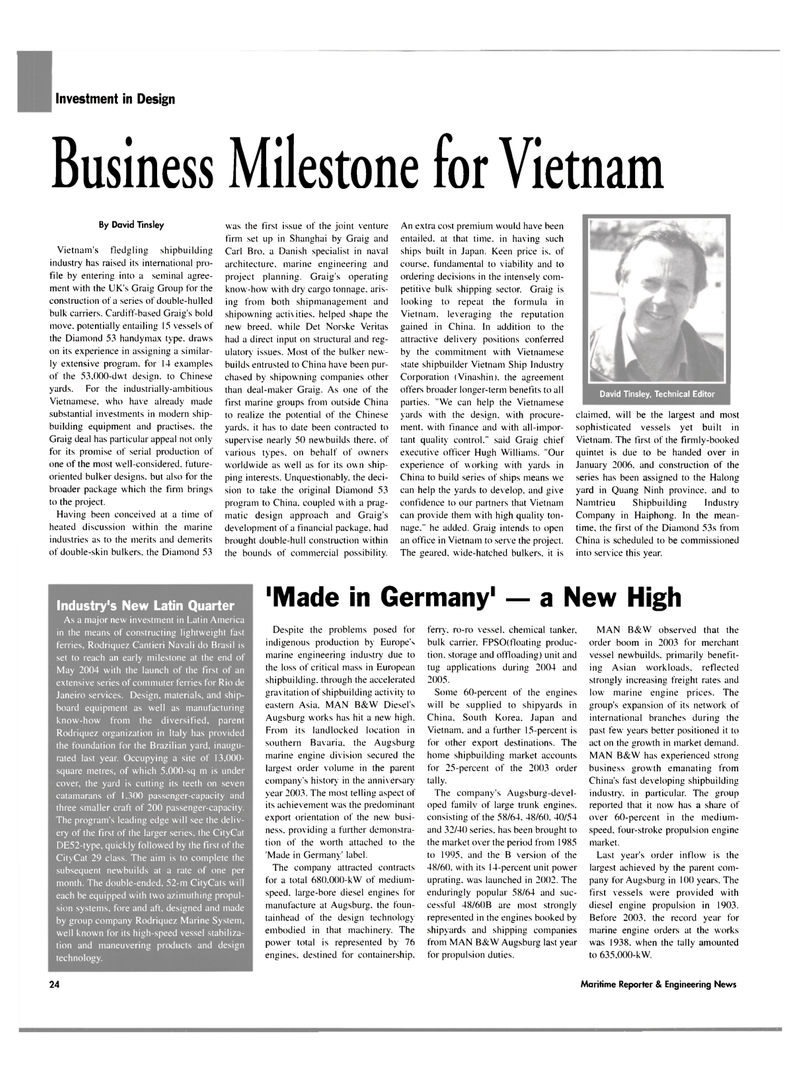
Page 24: of Maritime Reporter Magazine (March 2004)
The Cruise Shipping Edition
Read this page in Pdf, Flash or Html5 edition of March 2004 Maritime Reporter Magazine
Investment in Design
Business Milestone for Vietnam
By David Tinsley
Vietnam's fledgling shipbuilding industry has raised its international pro- file by entering into a seminal agree- ment with the UK's Graig Group for the construction of a series of double-hulled bulk carriers. Cardiff-based Graig's bold move, potentially entailing 15 vessels of the Diamond 53 handymax type, draws on its experience in assigning a similar- ly extensive program, for 14 examples of the 53,000-dwt design, to Chinese yards. For the industrially-ambitious
Vietnamese, who have already made substantial investments in modern ship- building equipment and practises, the
Graig deal has particular appeal not only for its promise of serial production of one of the most well-considered, future- oriented bulker designs, but also for the broader package which the firm brings to the project.
Having been conceived at a time of heated discussion within the marine industries as to the merits and demerits of double-skin bulkers. the Diamond 53 was the first issue of the joint venture firm set up in Shanghai by Graig and
Carl Bro, a Danish specialist in naval architecture, marine engineering and project planning. Graig's operating know-how with dry cargo tonnage, aris- ing from both shipmanagement and shipowning activities, helped shape the new breed, while Det Norske Veritas had a direct input on structural and reg- ulatory issues. Most of the bulker new- builds entrusted to China have been pur- chased by shipowning companies other than deal-maker Graig. As one of the first marine groups from outside China to realize the potential of the Chinese yards, it has to date been contracted to supervise nearly 50 newbuilds there, of various types, on behalf of owners worldwide as well as for its own ship- ping interests. Unquestionably, the deci- sion to take the original Diamond 53 program to China, coupled with a prag- matic design approach and Graig's development of a financial package, had brought double-hull construction within the bounds of commercial possibility.
An extra cost premium would have been entailed, at that time, in having such ships built in Japan. Keen price is. of course, fundamental to viability and to ordering decisions in the intensely com- petitive bulk shipping sector. Graig is looking to repeat the formula in
Vietnam, leveraging the reputation gained in China. In addition to the attractive delivery positions conferred by the commitment with Vietnamese state shipbuilder Vietnam Ship Industry
Corporation (Vinashin). the agreement offers broader longer-term benefits to all parties. "We can help the Vietnamese yards with the design, with procure- ment. with finance and with all-impor- tant quality control." said Graig chief executive officer Hugh Williams. "Our experience of working with yards in
China to build series of ships means we can help the yards to develop, and give confidence to our partners that Vietnam can provide them with high quality ton- nage." he added. Graig intends to open an office in Vietnam to serve the project.
The geared, wide-hatched bulkers, it is
David Tinsley, Technical Editor claimed, will be the largest and most sophisticated vessels yet built in
Vietnam. The first of the firmly-booked quintet is due to be handed over in
January 2006, and construction of the series has been assigned to the Halong yard in Quang Ninh province, and to
Namtrieu Shipbuilding Industry
Company in Haiphong. In the mean- time, the first of the Diamond 53s from
China is scheduled to be commissioned into service this year. "Made in Germany1 — a New High
Despite the problems posed for indigenous production by Europe's marine engineering industry due to the loss of critical mass in European shipbuilding, through the accelerated gravitation of shipbuilding activity to eastern Asia. MAN B&W Diesel's
Augsburg works has hit a new high.
From its landlocked location in southern Bavaria, the Augsburg marine engine division secured the largest order volume in the parent company's history in the anniversary year 2003. The most telling aspect of its achievement was the predominant export orientation of the new busi- ness. providing a further demonstra- tion of the worth attached to the 'Made in Germany' label.
The company attracted contracts for a total 680.000-kW of medium- speed, large-bore diesel engines for manufacture at Augsburg, the foun- tainhead of the design technology embodied in that machinery. The power total is represented by 76 engines, destined for containership. ferry, ro-ro vessel, chemical tanker, bulk carrier. FPSO(floating produc- tion. storage and offloading) unit and tug applications during 2004 and 2005.
Some 60-percent of the engines will be supplied to shipyards in
China. South Korea. Japan and
Vietnam, and a further 15-percent is for other export destinations. The home shipbuilding market accounts for 25-percent of the 2003 order tally.
The company's Augsburg-devel- oped famih of large trunk engines, consisting of the 58/64, 48/60. 40/54 and 32/40 series, has been brought to the market over the period from 1985 to 1995, and the B version of the 48/60. w ith its 14-percent unit power uprating, was launched in 2002. The enduringly popular 58/64 and suc- cessful 48/60B are most strongly represented in the engines booked by shipyards and shipping companies from MAN B&W Augsburg last year for propulsion duties.
MAN B&W observed that the order boom in 2003 for merchant vessel newbuilds, primarily benefit- ing Asian workloads, reflected strongly increasing freight rates and low marine engine prices. The group's expansion of its network of international branches during the past few years better positioned it to act on the growth in market demand.
MAN B&W has experienced strong business growth emanating from
China's fast developing shipbuilding industry, in particular. The group reported that it now has a share of over 60-percent in the medium- speed, four-stroke propulsion engine market.
Last year's order inflow is the largest achieved by the parent com- pany for Augsburg in 100 years. The first vessels were provided with diesel engine propulsion in 1903.
Before 2003. the record year for marine engine orders at the works was 1938, when the tally amounted to 635,000-kW.
Industry's New Latin Quarter
As a major new investment in Latin America in the means of constructing lightweight fast ferries, Rodriquez Cantieri Navali do Brasil is set to reach an early milestone at the end of
May 2004 with the launch of the first of an extensive series of commuter ferries for Rio de
Janeiro services. Design, materials, and ship- board equipment as well as manufacturing know-how from the diversified, parent
Rodriquez organization in Italy has provided the foundation for the Brazilian yard, inaugu- rated last year. Occupying a site of 13,000- square metres, of which 5,000-sq m is under cover, the yard is cutting its teeth on seven catamarans of 1.300 passenger-capacity and three smaller craft of 200 passenger-capacity.
The program's leading edge will see the deliv- ery of the first of the larger series, the CityCat
DE52-type, quickly followed by the first of the
CityCat 29 class. The aim is to complete the subsequent newbuilds at a rate of one per month. The double-ended, 52-m CityCats will each be equipped with two azimuthing propul- sion systems, fore and aft, designed and made by group company Rodriquez Marine System, well known for its high-speed vessel stabiliza- tion and maneuvering products and design technology. 24 Maritime Reporter & Engineering News

 23
23

 25
25
